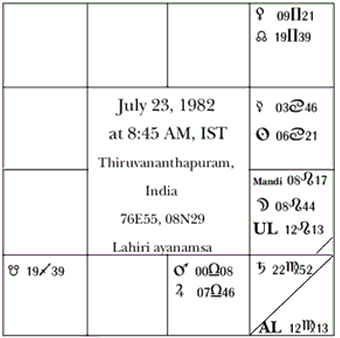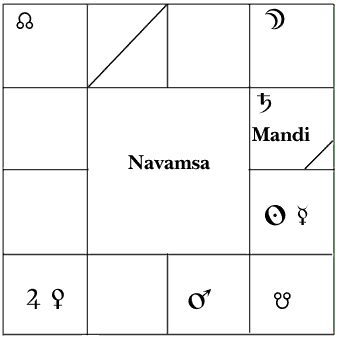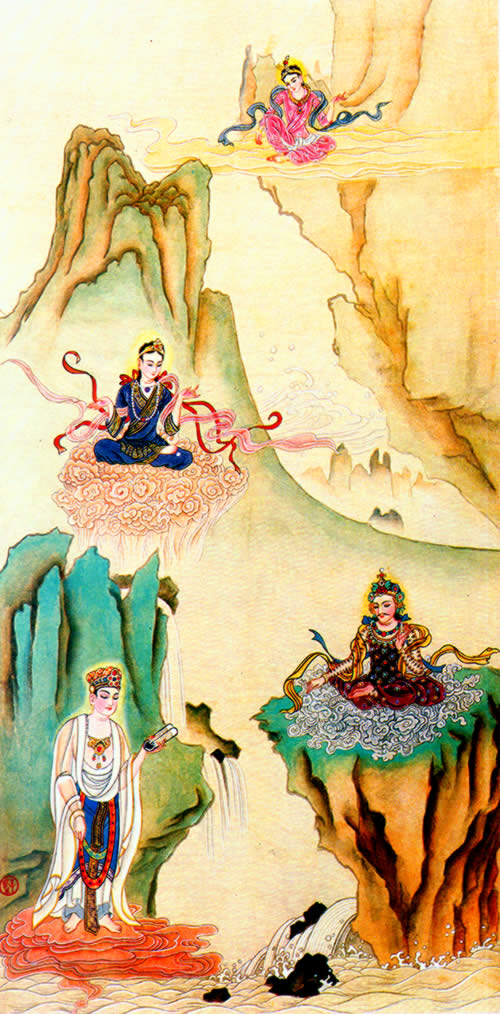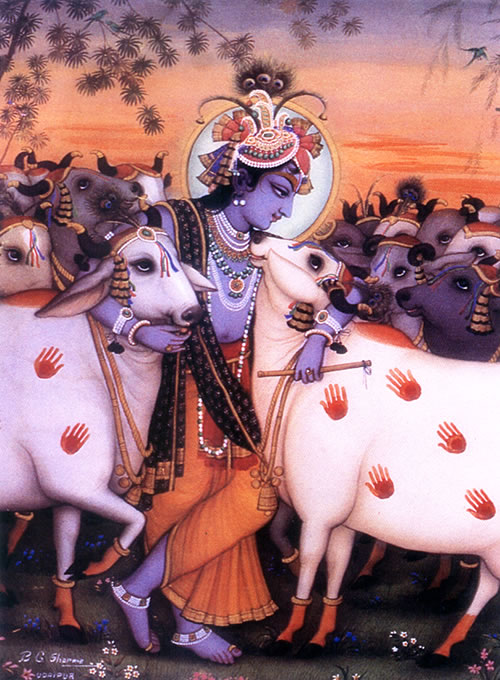Ashtamangala Deva Prashna
Page 2
1 2 3 4
The Prashna Begins
Observing Nimitta (Omens)
To begin the Ashtamangala Deva Prashna the astrologers first prepared a small, clean area of land and tidied it up and then covered it with a layer of raw rice. The questioners were asked to adorn it with a ghee lamp, white flowers and other ornaments as well as offerings such as Tambula (Pan leaves and Betel nut) that the congregation of the temple offered. They then performed puja (worship) with devotion on all the articles that would be used in the process of divination and invoked Lord Sri Krsna, the Supreme Personality of Godhead for His blessings. They then meditated on their istadevatas (personal patron deity, Lord Krsna or one of His avataras like Narasimhadeva or Lord Rama) for the ability to predict correctly.
The astrologers then called on an official of the temple with little or no knowledge of astrology to come forward. They showed him a Cakra (diagram of the zodiac) as it is drawn in typical South Indian style and ask him to duplicate it on the prepared ground. Using a stick he carefully prepared the diagram by first drawing the Western line, then the Southern line, then Eastern and finally the Northern line. (In Prasna the directions of the diagram are such: the side that has Aries and Taurus is East, Cancer and Leo is South, Libra and Scorpio is West, and Capricorn and Aquarius is North. Western astrologers should also note that in the S. Indian chart format the signs of the zodiac are stationary and the ascendant is drawn into the chart with a slash or letter. This is unlike the Western or North Indian system in which the ascendant is stationary and the signs arranged around it.)
The panditas noted down very carefully the order that he drew them. One stated that because the priest drew the Western line first it was a highly inauspicious omen indicating that diseases (or general harm) would increase. And this was made worse because he had drawn the other lines in a counter clockwise order which indicated many serious obstacles ahead. In general these two things were looked upon as unfavorable omens. They then looked for any irregularities in the way the lines were drawn, that is, if they were thick or thin, broken, etc. But none were observed.
Selecting the Swarna Lagna
The astrologers then called on any young child not conversant with astrology who was recently bathed and well dressed to come forward. The adults pushed a child forward, the astrologers directed the child to worship the ghee lamp and other divinatory paraphernalia with flowers. They then placed in the child's right hand a piece of gold, along with flowers, water, sandal wood paste and aksata - rice mixed with turmeric. The child was then instructed to go around the Cakra (wheel) of the zodiac and then stand near it facing east. In the mean time the questioner, the person who had called this convocation of astrologers, was instructed to be meditating on Lord Krsna to reveal His will. All the astrologers then reflected on the problems of the querist and repeated their mantras for inspiration, and the one astrologer who would do the Ashtamangala was touching his cowry shells. At the end they asked the child to deposit the gold in any one of the signs that had previously been drawn by the priest. The child placed the handful in the square designating Virgo.
It should be noted that the above two processes, that of drawing the Cakra and choosing the Arudha Lagna, would be impossible using the North Indian (or Western) format for drawing a chart. The North Indian format is based on houses not signs. For this and other reasons we recommend to students to strictly use the South Indian format, which evidence suggests is the original Vedic format. There is evidence to suggest that the North Indian format was introduced by Muslim invaders who dominated North India for nearly 800 years.
This Swarna Lagna ( swarna-gold, lagna-ascendant), as it is also known, became the Arudha Lagna for the ADP (represented by the long slash in the diagram). The Arudha Lagna, as we have seen, is chosen through a divinatory omen process directed by the will of Sri Krsna, much in the same way as other well known methods of divination such as Tarot and the I Ching. There are other ways of finding the Arudha Lagna, such as noting which part of the body the questioner is touching, the first letter of the first sound they make, what spot on the ground (of an imaginary zodiac projected onto the ground) they are standing on when asking the question, etc. The exact time the Swarna lagna was chosen was noted as 8:45 AM, thus the Udaya Lagna, the Lagna based on time, was Leo (short slash in diagram). The planetary positions at the time were fixed and the chart filled in with all the planets including Mandi, who is very significant in Kerala astrology and South India in general, but not much used in the North.
It should also be noted that there are some authors who never use Mandi in their practice of astrology but have put forward academic arguments concerning the proper way of calculating Mandi . Most modern computer programs that I have seen adopt these methods of calculation. However, when I wrote the Jyotish Vedic Astrology program for Matrix Software, (published 1988) I used an algorithm that duplicated the methods of Prashna Marga and the Kerala tradition as I saw it practiced. This seemed more logical to me because these astrologers actually use Mandi on a daily basis, Mandi is not an academic abstraction to them.
The exact degree of the Arudha lagna was calculated by noting the degree of the Udaya Lagna. Since the Udaya Lagna was 12LE13 thus the degree of the Arudha Lagna would be 12VI13. Therefore the Arudha navamsa would then be the fourth navamsa corresponding to Cancer. (Navamsa is an arc of 3 degree 20 minutes, one ninth of sign.)


While we do offer services on this site it is primarily educational. Any money that we make from our services go toward continued study and publishing of well-researched articles that set a high standard in the jyotish community. As a brahmana my primary vocation is to study and share my knowledge with others. In traditional Vedic culture the general public and especially those who benefit directly from that knowledge help to support the teacher so that he can spend more time in deep study and continue the cycle. If your knowledge has been expanded and you are inspired by the Lord in your heart please donate an amount that you are comfortable giving.

